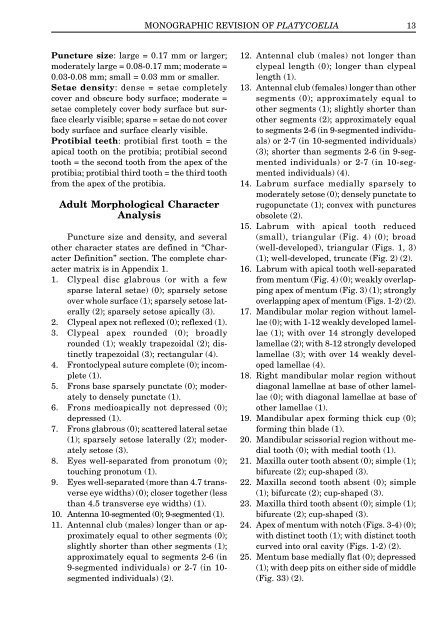Download full text (PDF 4.5 MB) - University of Nebraska State ...
Download full text (PDF 4.5 MB) - University of Nebraska State ...
Download full text (PDF 4.5 MB) - University of Nebraska State ...
You also want an ePaper? Increase the reach of your titles
YUMPU automatically turns print PDFs into web optimized ePapers that Google loves.
Puncture size: large = 0.17 mm or larger;<br />
moderately large = 0.08-0.17 mm; moderate =<br />
0.03-0.08 mm; small = 0.03 mm or smaller.<br />
Setae density: dense = setae completely<br />
cover and obscure body surface; moderate =<br />
setae completely cover body surface but surface<br />
clearly visible; sparse = setae do not cover<br />
body surface and surface clearly visible.<br />
Protibial teeth: protibial first tooth = the<br />
apical tooth on the protibia; protibial second<br />
tooth = the second tooth from the apex <strong>of</strong> the<br />
protibia; protibial third tooth = the third tooth<br />
from the apex <strong>of</strong> the protibia.<br />
Adult Morphological Character<br />
Analysis<br />
Puncture size and density, and several<br />
other character states are defined in “Character<br />
Definition” section. The complete character<br />
matrix is in Appendix 1.<br />
1. Clypeal disc glabrous (or with a few<br />
sparse lateral setae) (0); sparsely setose<br />
over whole surface (1); sparsely setose laterally<br />
(2); sparsely setose apically (3).<br />
2. Clypeal apex not reflexed (0); reflexed (1).<br />
3. Clypeal apex rounded (0); broadly<br />
rounded (1); weakly trapezoidal (2); distinctly<br />
trapezoidal (3); rectangular (4).<br />
4. Frontoclypeal suture complete (0); incomplete<br />
(1).<br />
5. Frons base sparsely punctate (0); moderately<br />
to densely punctate (1).<br />
6. Frons medioapically not depressed (0);<br />
depressed (1).<br />
7. Frons glabrous (0); scattered lateral setae<br />
(1); sparsely setose laterally (2); moderately<br />
setose (3).<br />
8. Eyes well-separated from pronotum (0);<br />
touching pronotum (1).<br />
9. Eyes well-separated (more than 4.7 transverse<br />
eye widths) (0); closer together (less<br />
than <strong>4.5</strong> transverse eye widths) (1).<br />
10. Antenna 10-segmented (0); 9-segmented (1).<br />
11. Antennal club (males) longer than or approximately<br />
equal to other segments (0);<br />
slightly shorter than other segments (1);<br />
approximately equal to segments 2-6 (in<br />
9-segmented individuals) or 2-7 (in 10segmented<br />
individuals) (2).<br />
MONOGRAPHIC REVISION OF PLATYCOELIA 13<br />
12. Antennal club (males) not longer than<br />
clypeal length (0); longer than clypeal<br />
length (1).<br />
13. Antennal club (females) longer than other<br />
segments (0); approximately equal to<br />
other segments (1); slightly shorter than<br />
other segments (2); approximately equal<br />
to segments 2-6 (in 9-segmented individuals)<br />
or 2-7 (in 10-segmented individuals)<br />
(3); shorter than segments 2-6 (in 9-segmented<br />
individuals) or 2-7 (in 10-segmented<br />
individuals) (4).<br />
14. Labrum surface medially sparsely to<br />
moderately setose (0); densely punctate to<br />
rugopunctate (1); convex with punctures<br />
obsolete (2).<br />
15. Labrum with apical tooth reduced<br />
(small), triangular (Fig. 4) (0); broad<br />
(well-developed), triangular (Figs. 1, 3)<br />
(1); well-developed, truncate (Fig. 2) (2).<br />
16. Labrum with apical tooth well-separated<br />
from mentum (Fig. 4) (0); weakly overlapping<br />
apex <strong>of</strong> mentum (Fig. 3) (1); strongly<br />
overlapping apex <strong>of</strong> mentum (Figs. 1-2) (2).<br />
17. Mandibular molar region without lamellae<br />
(0); with 1-12 weakly developed lamellae<br />
(1); with over 14 strongly developed<br />
lamellae (2); with 8-12 strongly developed<br />
lamellae (3); with over 14 weakly developed<br />
lamellae (4).<br />
18. Right mandibular molar region without<br />
diagonal lamellae at base <strong>of</strong> other lamellae<br />
(0); with diagonal lamellae at base <strong>of</strong><br />
other lamellae (1).<br />
19. Mandibular apex forming thick cup (0);<br />
forming thin blade (1).<br />
20. Mandibular scissorial region without medial<br />
tooth (0); with medial tooth (1).<br />
21. Maxilla outer tooth absent (0); simple (1);<br />
bifurcate (2); cup-shaped (3).<br />
22. Maxilla second tooth absent (0); simple<br />
(1); bifurcate (2); cup-shaped (3).<br />
23. Maxilla third tooth absent (0); simple (1);<br />
bifurcate (2); cup-shaped (3).<br />
24. Apex <strong>of</strong> mentum with notch (Figs. 3-4) (0);<br />
with distinct tooth (1); with distinct tooth<br />
curved into oral cavity (Figs. 1-2) (2).<br />
25. Mentum base medially flat (0); depressed<br />
(1); with deep pits on either side <strong>of</strong> middle<br />
(Fig. 33) (2).
















